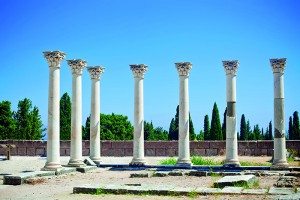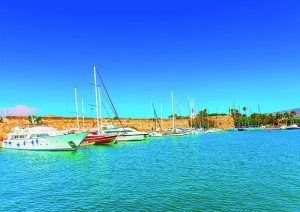The remains of ancient temples, revealing the significant, long history of the island, traditional settlements and picturesque villages built on the green slopes, an indented coastline “bathing” in the bright Greek sun and mountainous
pine trees make up the image of the island of Kos. It is “the most beautiful place under the sky” as the French François Poukeville, a Greek fan, doctor, diplomat and historian wrote.
The beautiful island of Kos has been standing proudly in the southeastern Aegean, between Nisyros and Kalymnos for centuries. It is the third island of the Dodecanese in
size, and the birthplace of Hippocrates, father of medicine (he was born on the island at around 460 BC), who founded the renowned Medical School of Kos.
There are traces of life in the island dating back to the third millennium BC, while, as is the case in the rest of the country, Romans, Venetians, Byzantines and Ottoman
conquerors have also left their indelible marks on the island.
However, those who played the most important role both in the history of the island and its image, as was the case with the rest of the islands of the Dodecanese, were
the Knights of St. John, who dominated Kos for more than two centuries.
There are dozens of monuments from that period. The imposing castle on the right side of the port as well as the castles of Antimacheia, Kefalos and old Pylios are tangible
examples of the presence of the Knights of St. John on the island.
The town of Kos is the capital and the port of the island. It is a modern town, built after the disastrous earthquake of 1933, with an exceptional layout, large streets and a lot of
green. The palm trees along the littoral road are the landmark of the town, adding exotic beauty to its image.
 Ancient structures, neoclassical with a Venetian style, traditional Dodecanese architecture and ultra modern buildings exist together in harmony, proving the diversity of Kos.
Ancient structures, neoclassical with a Venetian style, traditional Dodecanese architecture and ultra modern buildings exist together in harmony, proving the diversity of Kos.
It also worth mentioning that a remarkable network of cycling streets has developed in Kos that already stretches on a length of 24 kilometers, along the coastline, changing
the transportation habits both of the residents and the visitors.
Hippocrates’ plane tree on the homonymous square, allegedly planted by the ancient Greek doctor and philosopher 2.400 years ago, is a point of reference for the town.
The Venetian castle on the right side of the port, known as the castle of Neratzia, the bridge connecting the square of the Plane Tree with the entrance to the castle, the Ancient Agora, one of the biggest ever excavated in Greece until now, at a short distance from the port, the temple of Hercules, dating back to the 2nd century, the Roman Odeon,
one of the most important public buildings in Kos, excavated in 1929, Casa Romana, the Roman mansion of Pompeian architectural style dating back to the 3rd century
BC, the temple of St. John the Baptist, originally an old-Christian Baptistery of the 5th or 6th centuries, probably the only old-Christian Baptistery that is almost intact until
today and the mosque of Ghazi Hassan Pasha, known as the Lozia Mosque or the Plane Tree Mosque, are some of the most interesting sights.
However, the most important archaeological site of the island is the Asklepion, where Hippocrates used to teach.
It is only 4 kilometers away from the center, on the slopes of a small hill, with an excellent view to the sea, opposite the Turkish coast.
We can still see the shrine of Asclepius today, dating back to the 4th century BC, the temple of Apollo of the 3rd century BC and the temple of Asclepius, of the 2nd century
BC.
Picturesque villages and traditional sett lements
Visitors to Kos can see picturesque villages and traditional settlements reminiscent of the past and harmoniously combining the impressive past with the modern present.
Visitors to Asfendios will see running waters and an attractive green landscape, emerging from the green foothills of Mt. Dikaios. Quite close is the settlement of Zia, a meeting point for romantic visitors who climb up here to admire one of the most fascinating sunsets as well as the magnificent view of the island and the open sea from
above.
On the other side, towards the sea, there is Tigaki, with the wonderful 10 kilometer long sandy beach, the shallow crystal clear waters, which is an ideal choice for families
with young children as well as for surfers.
At a close distance visitors will see Marmari, with its long sandy beach, one of the most popular beaches of the island.+
Leaving Marmari and travelling towards the center of the island, visitors see Pyli, on a green flatland with olive trees. Palaio Pyli is right beside; it is a beautiful village
with traditional stone houses and next to that there areold Byzantine churches and the remains of the castle, travelling visitors back in time.
Antimacheia is in the center of the island. It is a picturesque small town, combining
natural beauty and authenticity with modern infrastructures and facilities in a
unique way. Its landmark is the Venetian castle, built by the Knights of St. John in
the 15th century AD, with the blazons of the Grand Magisters of the Order on its
gates, which is preserved in a very good condition. “Hippocrates”, the airport of
Kos is also in Antimacheia.
Mastichari, which is a quiet seaside village, renowned for its fresh fish and taverns is
also close. It has some of the most beautiful beaches, which are top choices for surfing
fans, since the waves in the open sea there are the ideal environment.
The image of Kardamaina is made up of tree planted stretches of land, modern
hotel units and tourist infrastructures, taverns, ouzo taverns, cafes and bars. Kardamaina
is built in the area of the ancient town of Alasarna, which was a significant
worship center of the Classical Antiquity.
Today it is the most popular tourist resort of the island.
On the west edge of the island, at a distance of 42 kilometers from the town of Kos, the picturesque town of Kefalos is an attraction pole for visitors. Kefalos is built on the
site of the ancient town of Kos, Astypalaia, some remains of which can still be seen today. The cave of Aspri Petra is also worth visiting, where the first human traces on the
island were found, is at a distance of 3 kilometers from Kefalos.
Golden beaches and popular tourist resorts
Clear seas, sandy beaches, spas and famous tourist resorts make Kos a popular tourist destination both for Greek and foreign tourists. Besides Tigaki, Marmari, Mastichari, Kardamaina and Kefalos, there are several other beaches, whether fully organized or pristine, inviting tourists to see them.
Agios Theologos is one of the most beautiful and maybe most distant beaches of Kos, 7 kilometers southwestern from Kefalos.
The scenery here is slightly different as the beach is rocky with very small sandy patches.
One kilometer away from Kefalos, Kamari, with its crystal clear waters and the endless, sandy beach, attracts a lot of people. Paradeisos (Paradise) on the other hand, with its
fine white sand, is exactly what the name implies.
Psalidi, at a very short distance from the town of Kos, with its big hotel units and the organized water sport centers, is on the island.
Agios Fokas is famous for its blue waters and the fact that nearly half of it has beautiful black sand and the other half has bright white sand and pebbles.
Close to Agios Fokas, there is Thermes, with its spas, reaching down the sea and warming it, and its black volcanic pebbles, attracting thousands of tourists every year.




